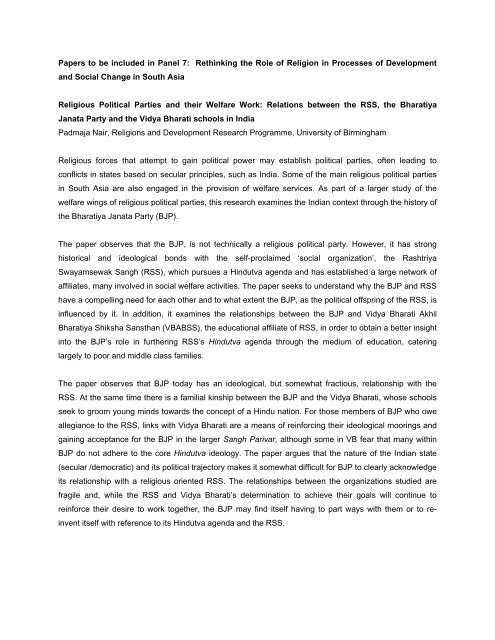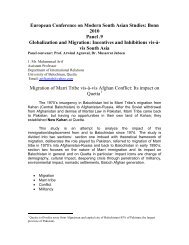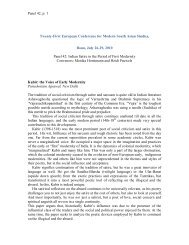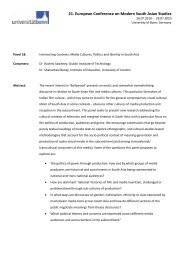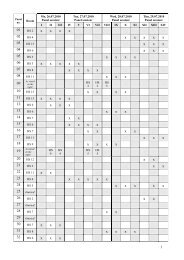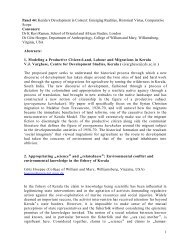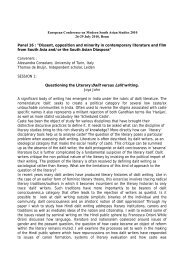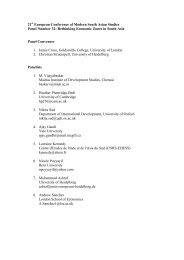Papers to be included in Panel 7: Rethinking the Role of Religion in ...
Papers to be included in Panel 7: Rethinking the Role of Religion in ...
Papers to be included in Panel 7: Rethinking the Role of Religion in ...
You also want an ePaper? Increase the reach of your titles
YUMPU automatically turns print PDFs into web optimized ePapers that Google loves.
<strong>Papers</strong> <strong>to</strong> <strong>be</strong> <strong><strong>in</strong>cluded</strong> <strong>in</strong> <strong>Panel</strong> 7: Reth<strong>in</strong>k<strong>in</strong>g <strong>the</strong> <strong>Role</strong> <strong>of</strong> <strong>Religion</strong> <strong>in</strong> Processes <strong>of</strong> Development<br />
and Social Change <strong>in</strong> South Asia<br />
Religious Political Parties and <strong>the</strong>ir Welfare Work: Relations <strong>be</strong>tween <strong>the</strong> RSS, <strong>the</strong> Bharatiya<br />
Janata Party and <strong>the</strong> Vidya Bharati schools <strong>in</strong> India<br />
Padmaja Nair, <strong>Religion</strong>s and Development Research Programme, University <strong>of</strong> Birm<strong>in</strong>gham<br />
Religious forces that attempt <strong>to</strong> ga<strong>in</strong> political power may establish political parties, <strong>of</strong>ten lead<strong>in</strong>g <strong>to</strong><br />
conflicts <strong>in</strong> states based on secular pr<strong>in</strong>ciples, such as India. Some <strong>of</strong> <strong>the</strong> ma<strong>in</strong> religious political parties<br />
<strong>in</strong> South Asia are also engaged <strong>in</strong> <strong>the</strong> provision <strong>of</strong> welfare services. As part <strong>of</strong> a larger study <strong>of</strong> <strong>the</strong><br />
welfare w<strong>in</strong>gs <strong>of</strong> religious political parties, this research exam<strong>in</strong>es <strong>the</strong> Indian context through <strong>the</strong> his<strong>to</strong>ry <strong>of</strong><br />
<strong>the</strong> Bharatiya Janata Party (BJP).<br />
The paper observes that <strong>the</strong> BJP, is not technically a religious political party. However, it has strong<br />
his<strong>to</strong>rical and ideological bonds with <strong>the</strong> self-proclaimed ‘social organization’, <strong>the</strong> Rashtriya<br />
Swayamsewak Sangh (RSS), which pursues a H<strong>in</strong>dutva agenda and has established a large network <strong>of</strong><br />
affiliates, many <strong>in</strong>volved <strong>in</strong> social welfare activities. The paper seeks <strong>to</strong> understand why <strong>the</strong> BJP and RSS<br />
have a compell<strong>in</strong>g need for each o<strong>the</strong>r and <strong>to</strong> what extent <strong>the</strong> BJP, as <strong>the</strong> political <strong>of</strong>fspr<strong>in</strong>g <strong>of</strong> <strong>the</strong> RSS, is<br />
<strong>in</strong>fluenced by it. In addition, it exam<strong>in</strong>es <strong>the</strong> relationships <strong>be</strong>tween <strong>the</strong> BJP and Vidya Bharati Akhil<br />
Bharatiya Shiksha Sansthan (VBABSS), <strong>the</strong> educational affiliate <strong>of</strong> RSS, <strong>in</strong> order <strong>to</strong> obta<strong>in</strong> a <strong>be</strong>tter <strong>in</strong>sight<br />
<strong>in</strong><strong>to</strong> <strong>the</strong> BJP’s role <strong>in</strong> fur<strong>the</strong>r<strong>in</strong>g RSS’s H<strong>in</strong>dutva agenda through <strong>the</strong> medium <strong>of</strong> education, cater<strong>in</strong>g<br />
largely <strong>to</strong> poor and middle class families.<br />
The paper observes that BJP <strong>to</strong>day has an ideological, but somewhat fractious, relationship with <strong>the</strong><br />
RSS. At <strong>the</strong> same time <strong>the</strong>re is a familial k<strong>in</strong>ship <strong>be</strong>tween <strong>the</strong> BJP and <strong>the</strong> Vidya Bharati, whose schools<br />
seek <strong>to</strong> groom young m<strong>in</strong>ds <strong>to</strong>wards <strong>the</strong> concept <strong>of</strong> a H<strong>in</strong>du nation. For those mem<strong>be</strong>rs <strong>of</strong> BJP who owe<br />
allegiance <strong>to</strong> <strong>the</strong> RSS, l<strong>in</strong>ks with Vidya Bharati are a means <strong>of</strong> re<strong>in</strong>forc<strong>in</strong>g <strong>the</strong>ir ideological moor<strong>in</strong>gs and<br />
ga<strong>in</strong><strong>in</strong>g acceptance for <strong>the</strong> BJP <strong>in</strong> <strong>the</strong> larger Sangh Parivar, although some <strong>in</strong> VB fear that many with<strong>in</strong><br />
BJP do not adhere <strong>to</strong> <strong>the</strong> core H<strong>in</strong>dutva ideology. The paper argues that <strong>the</strong> nature <strong>of</strong> <strong>the</strong> Indian state<br />
(secular /democratic) and its political trajec<strong>to</strong>ry makes it somewhat difficult for BJP <strong>to</strong> clearly acknowledge<br />
its relationship with a religious oriented RSS. The relationships <strong>be</strong>tween <strong>the</strong> organizations studied are<br />
fragile and, while <strong>the</strong> RSS and Vidya Bharati’s determ<strong>in</strong>ation <strong>to</strong> achieve <strong>the</strong>ir goals will cont<strong>in</strong>ue <strong>to</strong><br />
re<strong>in</strong>force <strong>the</strong>ir desire <strong>to</strong> work <strong>to</strong>ge<strong>the</strong>r, <strong>the</strong> BJP may f<strong>in</strong>d itself hav<strong>in</strong>g <strong>to</strong> part ways with <strong>the</strong>m or <strong>to</strong> re<strong>in</strong>vent<br />
itself with reference <strong>to</strong> its H<strong>in</strong>dutva agenda and <strong>the</strong> RSS.
Constitution, <strong>Religion</strong> and Women’s Education Contradiction and Convergence<br />
Rub<strong>in</strong>a Saigol, <strong>Religion</strong>s and Development Research Programme, University <strong>of</strong> Birm<strong>in</strong>gham<br />
This paper proposes <strong>to</strong> exam<strong>in</strong>e <strong>the</strong> complex relationship <strong>be</strong>tween Pakistan’s constitution, <strong>the</strong> varied and<br />
multiple discourses <strong>of</strong> religious organizations, and <strong>the</strong> issue <strong>of</strong> women’s education. The paper would <strong>be</strong><br />
<strong>in</strong> two parts. In <strong>the</strong> first part, <strong>the</strong> constitution <strong>of</strong> Pakistan will <strong>be</strong> explored <strong>in</strong> terms <strong>of</strong> its provisions on<br />
women’s rights as well as education. These will <strong>be</strong> juxtaposed <strong>to</strong> <strong>the</strong> constitutional provisions on religion<br />
<strong>to</strong> identify and explore <strong>the</strong> contradictions as well as convergences <strong>be</strong>tween <strong>the</strong> overlapp<strong>in</strong>g, yet discrete<br />
discourses.<br />
In <strong>the</strong> second part, <strong>the</strong> state’s discourses on religion, and women’s rights and education will <strong>be</strong> compared<br />
with <strong>the</strong> f<strong>in</strong>d<strong>in</strong>gs <strong>of</strong> <strong>the</strong> study <strong>of</strong> women’s education undertaken <strong>in</strong> Peshawar and Lahore for <strong>the</strong> <strong>Religion</strong>s<br />
and Development Component on Values and Beliefs <strong>in</strong> <strong>Religion</strong> and <strong>the</strong>ir relationship <strong>to</strong> development<br />
concepts.<br />
The idea is <strong>to</strong> understand <strong>the</strong> complexity <strong>of</strong> <strong>the</strong> relation <strong>be</strong>tween religion, development discourses and<br />
women’s education, at <strong>the</strong> levels <strong>of</strong> both <strong>the</strong> state and religious organizations/parties. The contradictions<br />
as well as convergence and overlaps will <strong>be</strong> exam<strong>in</strong>ed <strong>to</strong> f<strong>in</strong>d out <strong>the</strong> extent <strong>to</strong> which <strong>the</strong> state and faithbased<br />
organizations are impediments or facilita<strong>to</strong>rs <strong>of</strong> women’s rights <strong>in</strong> general and education <strong>in</strong><br />
particular.<br />
An Uneasy Relationship: <strong>Religion</strong>, Philanthropy and Development <strong>in</strong> Karachi<br />
Nida Kirmani, University <strong>of</strong> Birm<strong>in</strong>gham and Sarah Zaidi, International Treatment Preparedness Coalition<br />
This paper explores <strong>the</strong> role <strong>of</strong> religion <strong>in</strong> philanthropic activities and <strong>in</strong> development <strong>in</strong>itiatives <strong>in</strong> Karachi,<br />
Pakistan. The authors discuss <strong>the</strong> different approaches <strong>to</strong> development taken by organisations that are<br />
locally grown and rely on <strong>in</strong>digenous sources <strong>of</strong> fund<strong>in</strong>g and non-religiously affiliated NGOs, which are<br />
largely reliant on foreign fund<strong>in</strong>g. The authors argue that locally-funded charitable <strong>in</strong>stitutions do not<br />
frame <strong>the</strong>mselves as part <strong>of</strong> <strong>the</strong> NGO-led ‘development sec<strong>to</strong>r’ even if many <strong>of</strong> <strong>the</strong>ir activities are focused<br />
on serv<strong>in</strong>g <strong>the</strong> poor. The drive <strong>to</strong> engage <strong>in</strong> philanthropy <strong>in</strong> Pakistan is closely tied <strong>to</strong> religious practice,<br />
with <strong>the</strong> majority <strong>of</strong> fund<strong>in</strong>g orig<strong>in</strong>at<strong>in</strong>g <strong>in</strong> religious forms <strong>of</strong> giv<strong>in</strong>g such as zakat and sadqa. Hence,<br />
although <strong>the</strong>se organisations may not identify <strong>the</strong>mselves explicitly as ‘faith-based organisations’, religion<br />
is <strong>in</strong>timately <strong>in</strong>tertw<strong>in</strong>ed with <strong>the</strong>ir identity and practice. Christian organisations are an exception <strong>to</strong> this<br />
rule <strong>be</strong>cause <strong>of</strong> <strong>the</strong>ir position as mem<strong>be</strong>rs <strong>of</strong> m<strong>in</strong>ority groups and due <strong>to</strong> <strong>the</strong>ir participation <strong>in</strong> <strong>in</strong>ternational<br />
networks. NGOs, on <strong>the</strong> o<strong>the</strong>r hand, speak <strong>the</strong> language <strong>of</strong> ‘development’, and do not actively<br />
<strong>in</strong>corporate religion <strong>in</strong><strong>to</strong> <strong>the</strong>ir work. The role <strong>of</strong> religion <strong>in</strong> <strong>the</strong>se sec<strong>to</strong>rs <strong>of</strong> civil society must <strong>be</strong><br />
unders<strong>to</strong>od <strong>in</strong> <strong>the</strong> wider context <strong>of</strong> both <strong>the</strong> Pakistani state, which has his<strong>to</strong>rically appropriated religion for
its own purposes, and <strong>the</strong> <strong>in</strong>ternational donor community’s uneasy relationship with Islam. Both<br />
charitable <strong>in</strong>stitutions and non-religious NGOs rarely class <strong>the</strong>mselves as ‘faith-based organisations’,<br />
<strong>be</strong>cause <strong>of</strong> <strong>the</strong> general fear surround<strong>in</strong>g religious la<strong>be</strong>ls <strong>in</strong> <strong>the</strong> context <strong>of</strong> Pakistan’s ‘War on Terror’. This<br />
research contributes <strong>to</strong> <strong>the</strong> wider understand<strong>in</strong>g <strong>of</strong> ‘faith-based organisations’ and compet<strong>in</strong>g notions <strong>of</strong><br />
‘development’ <strong>in</strong> Pakistan and <strong>be</strong>yond.<br />
Shift<strong>in</strong>g Identities, His<strong>to</strong>ries and Networks: Educational FBOs <strong>in</strong> Mumbai<br />
Mart<strong>in</strong> Rew, University <strong>of</strong> Birm<strong>in</strong>gham and Emma Tomal<strong>in</strong>, University <strong>of</strong> Leeds,<br />
Development organizations, particularly NGOs, have <strong>of</strong>ten <strong>be</strong>en characterized as mov<strong>in</strong>g from a<br />
charitable and welfare orientation, through <strong>to</strong> developmental and advocacy based <strong>in</strong>terventions. Faithbased<br />
organizations have also witnessed similar shifts and argued that, like NGOs, <strong>the</strong>y have a<br />
comparative advantage through <strong>the</strong>ir pragmatic, socio-economic and cultural proximity <strong>to</strong> <strong>the</strong> poor. This<br />
welfare through <strong>to</strong> advocacy trajec<strong>to</strong>ry has <strong>be</strong>en characteristic <strong>of</strong> non-state ac<strong>to</strong>r <strong>in</strong>volvement <strong>in</strong> <strong>the</strong> field<br />
<strong>of</strong> education with<strong>in</strong> India where religious <strong>in</strong>stitutions have, his<strong>to</strong>rically, provided important safety nets,<br />
while <strong>in</strong>creas<strong>in</strong>gly <strong>be</strong><strong>in</strong>g central <strong>to</strong> educational provision and nation-build<strong>in</strong>g. However, this paper will<br />
challenge <strong>the</strong> relevance <strong>of</strong> this depiction <strong>of</strong> a policy and organizational pathway - largely def<strong>in</strong>ed by<br />
development management perspectives - through <strong>the</strong> perspectives <strong>of</strong> two faith-based educational<br />
organizations from m<strong>in</strong>ority socio-religious groups <strong>in</strong> Mumbai; namely MESCO (an educational Islamic<br />
trust) and Shelter Don Bosco, an <strong>in</strong>ternational Catholic charity. The paper argues that <strong>the</strong> analysis <strong>of</strong> FBO<br />
engagement needs <strong>to</strong> <strong>in</strong>corporate more sociologically and his<strong>to</strong>rically <strong>in</strong>tegrated understand<strong>in</strong>gs <strong>of</strong> FBO<br />
social and political networks and identities. The paper shows that while target<strong>in</strong>g <strong>the</strong> same demographic<br />
group (young people from ‘impoverished’ backgrounds <strong>be</strong>tween <strong>the</strong> ages <strong>of</strong> 7-18) both organisations<br />
project different class aspirations, and images <strong>of</strong> self-improvement and religious identity, <strong>in</strong> response <strong>to</strong><br />
both local, national and <strong>in</strong>ternational discourses around appropriate ‘religious’ <strong>in</strong>tervention. Ultimately,<br />
<strong>the</strong> paper will <strong>be</strong> specifically concerned with exam<strong>in</strong><strong>in</strong>g how such organizations accommodate religious<br />
pluralism <strong>in</strong> response <strong>to</strong> both educational policy and society with<strong>in</strong> Mumbai and its implications for how<br />
<strong>the</strong> future city might <strong>be</strong> envisaged <strong>in</strong> socio-religious terms.<br />
Religious Transnationalism and New Development Initiatives <strong>in</strong> South Asia: a Case Study <strong>of</strong><br />
Ravidassias <strong>in</strong> <strong>the</strong> West Midlands, United K<strong>in</strong>gdom<br />
Gurharpal S<strong>in</strong>gh, University <strong>of</strong> Birm<strong>in</strong>gham (RaD)<br />
In recent years <strong>the</strong>re has <strong>be</strong>en an <strong>in</strong>creas<strong>in</strong>g recognition <strong>of</strong> <strong>the</strong> role <strong>of</strong> migrants’ remittances <strong>in</strong><br />
development <strong>of</strong> <strong>the</strong> South. In 2006, <strong>the</strong> World Bank estimated that remittances <strong>to</strong> <strong>the</strong> South from <strong>the</strong><br />
North amounted <strong>to</strong> $167 billion, with possibly an additional 50 per cent transferred through un<strong>of</strong>ficial
channels. The size <strong>of</strong> <strong>the</strong>se flows varies considerably with different communities, with <strong>the</strong> Ch<strong>in</strong>ese,<br />
Mexicans and Indians command<strong>in</strong>g a large proportion <strong>of</strong> <strong>the</strong>se transfers. In India, economic li<strong>be</strong>ralisation<br />
s<strong>in</strong>ce 1991 has <strong>be</strong>en followed by organised efforts <strong>to</strong> channel non-resident Indian <strong>in</strong>vestment <strong>in</strong><strong>to</strong> <strong>the</strong><br />
Indian economy by new policy <strong>in</strong>itiatives.<br />
Although migrants’ remittances have attracted considerable scholarship, researcher have overlooked <strong>the</strong><br />
impact <strong>of</strong> ‘social remittances’ - <strong>the</strong> transfer <strong>of</strong> ‘ideas, norms and values’ <strong>to</strong> <strong>the</strong> home country - and <strong>the</strong> role<br />
<strong>of</strong> religious organisations <strong>in</strong> <strong>the</strong> North <strong>of</strong> migrants from <strong>the</strong> South <strong>of</strong> poor and marg<strong>in</strong>alised communities<br />
<strong>in</strong> promot<strong>in</strong>g religiously based philanthropy that also addresses issues <strong>of</strong> <strong>in</strong>equality, social uplift and good<br />
governance.<br />
This paper will exam<strong>in</strong>e <strong>the</strong> efforts <strong>of</strong> <strong>the</strong> Ravidassia community <strong>in</strong> <strong>the</strong> United K<strong>in</strong>gdom – traditional <strong>of</strong> low<br />
caste/ agricultural workers from Punjab - <strong>to</strong> mobilise funds for economic and social development <strong>in</strong> central<br />
Punjab, India. It will assess how issues <strong>of</strong> religion and caste identity are central <strong>to</strong> such mobilisation <strong>in</strong> <strong>the</strong><br />
United K<strong>in</strong>gdom and <strong>the</strong> impact <strong>of</strong> resources and ideas transferred <strong>to</strong> Punjab for social and economic<br />
development channelled through <strong>the</strong> Dera Sach Khand Ballan, based <strong>in</strong> <strong>the</strong> central district <strong>of</strong> Jalandhar.<br />
The paper will argue that <strong>the</strong> case study provides a framework for look<strong>in</strong>g at new transnationalism<br />
religious movements <strong>of</strong> marg<strong>in</strong>alised groups. These groups have a significant contribution <strong>to</strong> make <strong>to</strong><br />
economic development that is not fully captured by <strong>the</strong> literature on religious philanthropy <strong>in</strong> South Asia or<br />
much more broadly.<br />
<strong>Religion</strong> and Politics <strong>in</strong> Pakistan<br />
Mohammed Waseem, Lahore University <strong>of</strong> Management Sciences<br />
This paper argues <strong>in</strong> favour <strong>of</strong> de-essentializ<strong>in</strong>g Islam, as opposed <strong>to</strong> its understand<strong>in</strong>g <strong>in</strong> terms <strong>of</strong><br />
conflation <strong>be</strong>tween religion and politics by ulema as well as Western scholars. As a schematized religious<br />
system, Islam operates <strong>in</strong> Pakistan <strong>in</strong> pursuit <strong>of</strong> programmatic reorder<strong>in</strong>g <strong>of</strong> <strong>the</strong> state and society.<br />
<strong>Religion</strong> has moved from an <strong>in</strong>strument <strong>of</strong> state policy <strong>to</strong> a socially em<strong>be</strong>dded ideological force. The<br />
Islamic discourse projects a div<strong>in</strong>e source <strong>of</strong> legitimacy superior <strong>to</strong> constitutionalism. It discounts issues<br />
relat<strong>in</strong>g <strong>to</strong> democracy, m<strong>in</strong>orities, women, human rights and public access <strong>to</strong> justice. The paper discusses<br />
<strong>the</strong> his<strong>to</strong>rical progression <strong>of</strong> Islamic politics through <strong>the</strong> colonial heritage <strong>of</strong> reification <strong>of</strong> religious<br />
identities lead<strong>in</strong>g <strong>to</strong> Muslim separatism, <strong>the</strong> post-<strong>in</strong>dependence nation-build<strong>in</strong>g project focus<strong>in</strong>g on Islamic<br />
unity, religious and sectarian movements, Islamization <strong>of</strong> law, education and economy and <strong>the</strong> war<br />
aga<strong>in</strong>st terror. The paper po<strong>in</strong>ts <strong>to</strong> <strong>the</strong> need <strong>to</strong> go <strong>be</strong>yond <strong>the</strong> conception <strong>of</strong> Islam as transhis<strong>to</strong>rical<br />
essence based on <strong>the</strong> hermeneutics <strong>of</strong> <strong>the</strong> text <strong>to</strong> a liv<strong>in</strong>g experience <strong>of</strong> a modern constitutional state.
Conceiv<strong>in</strong>g ‘Development’: Aga Khan III and Some Aspects <strong>of</strong> an Islamic Welfarism <strong>in</strong> Twentieth<br />
Century South Asia<br />
Soumen Mukherjee, Department <strong>of</strong> His<strong>to</strong>ry, SAI, University <strong>of</strong> Heidel<strong>be</strong>rg<br />
The role <strong>of</strong> religion <strong>in</strong> conceiv<strong>in</strong>g human welfare, and mak<strong>in</strong>g and execut<strong>in</strong>g policies ensur<strong>in</strong>g an aspired<br />
degree <strong>of</strong> development <strong>in</strong> <strong>the</strong> context <strong>of</strong> colonial and post-colonial South Asia still rema<strong>in</strong>s by and large<br />
unexplored. The present paper seeks <strong>to</strong> attenuate this lacuna by look<strong>in</strong>g at a his<strong>to</strong>rical example: <strong>the</strong><br />
politico-religious career <strong>of</strong> Aga Khan III Sultan Muhammad Shah (1877-1957), spiritual leader <strong>of</strong> <strong>the</strong><br />
Khoja Ismailis and prom<strong>in</strong>ent Muslim political personality <strong>in</strong> South Asia. Be<strong>in</strong>g <strong>the</strong> spiritual head <strong>of</strong> a subsect<br />
not considered by <strong>the</strong> bulk <strong>of</strong> <strong>the</strong> Muslims — both Sunnis and Ithna Ashariya Shias — <strong>to</strong> <strong>be</strong> one <strong>of</strong><br />
<strong>the</strong>m, <strong>the</strong> greatest challenge that he faced <strong>in</strong> his political career was probably forg<strong>in</strong>g a l<strong>in</strong>kage with <strong>the</strong><br />
broader Muslim qaum <strong>of</strong> South Asia along political l<strong>in</strong>es without dilut<strong>in</strong>g some <strong>of</strong> <strong>the</strong> crucial religious<br />
particularities <strong>of</strong> his own sub-sect (e.g. ma<strong>in</strong>tenance <strong>of</strong> his own religious position). Much <strong>of</strong> this l<strong>in</strong>kage<br />
could <strong>be</strong>come possible thanks primarily <strong>to</strong> his astute socio-political visions that conceived <strong>of</strong> a picture<br />
broad enough <strong>to</strong> accommodate <strong>the</strong> general and particular socio-political and economic issues assertively<br />
claimed <strong>to</strong> <strong>be</strong> affect<strong>in</strong>g almost all strands <strong>of</strong> South Asia’s Muslim society. A politics <strong>of</strong> compromise with a<br />
tacit <strong>be</strong>lief <strong>in</strong> <strong>the</strong> <strong>be</strong>nevolence <strong>of</strong> British rule <strong>be</strong>came <strong>the</strong> hallmark <strong>of</strong> this vision; at <strong>the</strong> level <strong>of</strong><br />
communication, <strong>the</strong> idea <strong>of</strong> ‘transition’ (affect<strong>in</strong>g o<strong>the</strong>r communities <strong>in</strong> South Asia as well) — first voiced <strong>in</strong><br />
1918 — <strong>be</strong>came its rhe<strong>to</strong>ric. With due reference <strong>to</strong> <strong>the</strong> cognitive (<strong>in</strong>ternal) and contextual (external)<br />
realms, <strong>the</strong> paper deconstructs Aga Khan III’s visions and choices with reference <strong>to</strong> what social scientists<br />
call ‘path dependent analysis’. It assesses <strong>the</strong> role <strong>of</strong> <strong>the</strong> religious values (<strong>of</strong> his brand <strong>of</strong> Islam) <strong>in</strong><br />
conceptualis<strong>in</strong>g (and <strong>in</strong>deed, f<strong>in</strong>d<strong>in</strong>g solutions <strong>to</strong>) a whole spectrum <strong>of</strong> socio-political and economic<br />
problems and Horizontal Inequalities (HIs), and evolv<strong>in</strong>g a discourse <strong>of</strong> welfarism <strong>in</strong> late colonial South<br />
Asia and subsequently <strong>the</strong> newly <strong>in</strong>dependent countries after 1947. This will help shed light on <strong>the</strong><br />
ideological and <strong>in</strong>spirational roots <strong>of</strong> much <strong>of</strong> <strong>the</strong> social policy framed under his successor, Aga Khan IV<br />
Pr<strong>in</strong>ce Karim, and articulated through <strong>the</strong> wide network called <strong>the</strong> Aga Khan Development Network<br />
(AKDN).<br />
Between ‘<strong>Religion</strong>’ and ‘Development’: Chang<strong>in</strong>g Ideas <strong>of</strong> Philanthropy <strong>in</strong> Urban Ahmedabad<br />
Rub<strong>in</strong>a Jasani, University <strong>of</strong> Warwick<br />
This paper maps <strong>the</strong> his<strong>to</strong>rical shifts <strong>in</strong> <strong>the</strong> development discourse with<strong>in</strong> <strong>the</strong> city <strong>of</strong> Ahmedabad from<br />
early n<strong>in</strong>eteenth century <strong>to</strong> <strong>the</strong> contemporary period. It shows how notions <strong>of</strong> philanthropy and<br />
development with<strong>in</strong> <strong>the</strong> city were shaped by <strong>the</strong> unique <strong>in</strong>dustrial, social and political context <strong>of</strong> <strong>the</strong> city,<br />
which were em<strong>be</strong>dded with<strong>in</strong> <strong>the</strong> religious <strong>be</strong>liefs <strong>of</strong> <strong>the</strong> rul<strong>in</strong>g elites. This status-quo was challenged <strong>in</strong><br />
<strong>the</strong> post-<strong>in</strong>dependence period where notions <strong>of</strong> development were <strong>in</strong>troduced by Nehru. The agenda <strong>of</strong><br />
<strong>the</strong> religious m<strong>in</strong>orities was peripheral <strong>to</strong> this agenda. It was only after his<strong>to</strong>rical ruptures like <strong>the</strong>
earthquake <strong>of</strong> 2001 and <strong>the</strong> episode <strong>of</strong> communal violence <strong>of</strong> 2002, where <strong>the</strong> protection and well <strong>be</strong><strong>in</strong>g<br />
<strong>of</strong> <strong>the</strong> religious m<strong>in</strong>orities <strong>be</strong>came a concern. What provided <strong>the</strong> Muslims this k<strong>in</strong>d <strong>of</strong> public visibility?<br />
Who responded <strong>to</strong> <strong>the</strong>se concerns? Who mobilised help for <strong>the</strong> community and who delivered this help?<br />
Did notions <strong>of</strong> development and philanthropy get re-fashioned or did Muslims have a parallel system <strong>of</strong><br />
<strong>the</strong>ir own? Are some <strong>of</strong> <strong>the</strong> questions this paper will address.<br />
While <strong>the</strong> his<strong>to</strong>rical context <strong>of</strong> <strong>the</strong> paper will <strong>be</strong> derived from a review <strong>of</strong> secondary literature, <strong>the</strong><br />
ethnographic context comes from my fieldwork after <strong>the</strong> violence <strong>of</strong> 2002 <strong>in</strong> Gujarat.<br />
‘The people know <strong>the</strong>y need religion <strong>in</strong> order <strong>to</strong> develop’: relationships <strong>be</strong>tween H<strong>in</strong>du religious<br />
teach<strong>in</strong>gs, values and <strong>be</strong>liefs and concepts <strong>of</strong> development <strong>in</strong> Pune, India<br />
Tams<strong>in</strong> Bradley, London Metropolitan University and Zara Ramsay, School <strong>of</strong> Oriental and African<br />
Studies<br />
This paper is based on research carried out <strong>in</strong> urban and rural Pune and reveals that H<strong>in</strong>duism has<br />
significant <strong>in</strong>fluence on how local people conceptualize and talk about development. However <strong>the</strong> ways <strong>in</strong><br />
which religion <strong>in</strong>tersects with views about (and <strong>the</strong> experience <strong>of</strong>) development vary with context<br />
(urban/rural), caste identity (lower/upper caste) and level <strong>of</strong> prosperity (middle class/poor). The nature <strong>of</strong><br />
people’s daily lives and experiences shapes <strong>the</strong>ir <strong>in</strong>terpretations <strong>of</strong> religion and <strong>the</strong>se <strong>in</strong> turn <strong>in</strong>fluence<br />
<strong>the</strong>ir views about development. <strong>Religion</strong> is both a source <strong>of</strong> social and spiritual capital and a means <strong>to</strong><br />
acquire or facilitate development. Ethnographic research was carried out <strong>in</strong>side slum settlements, <strong>in</strong> rural<br />
Pune and <strong>in</strong> three H<strong>in</strong>du organizations popular with middle class devotees: The Ramakrishna Movement,<br />
Guru Mata Amritanandamayi and The Sadhu Vaswani Mission. Gender emerged as a central lens<br />
through which <strong>the</strong>se organisations talked about <strong>the</strong>ir values. Gender also emerged as a significant fac<strong>to</strong>r<br />
shap<strong>in</strong>g peoples perspectives on selected (and sometimes contentious) elements <strong>of</strong> <strong>the</strong> ma<strong>in</strong>stream<br />
development discourse: wealth and poverty, and women’s education. The paper reveals a stark<br />
disjuncture <strong>be</strong>tween <strong>the</strong> visions <strong>of</strong> development articulated by poor, low caste H<strong>in</strong>dus and middle-class<br />
devotees <strong>of</strong> <strong>the</strong> organisations studied. For both groups religion is a fundamental dimension <strong>of</strong> <strong>the</strong>ir lives<br />
through which <strong>the</strong>y make sense <strong>of</strong> life and practically negotiate a <strong>be</strong>tter existence.
Religious Mobilizations for Development and Social Change: A Comparative Study <strong>of</strong> Dalit<br />
Movements <strong>in</strong> Punjab and Maharashtra, India<br />
Sur<strong>in</strong>der S. Jodhka, Jawaharlal Nehru University<br />
Based on qualitative fieldwork <strong>in</strong> Punjab and Maharashtra <strong>in</strong> India <strong>the</strong> paper looks at religious<br />
mobilizations among <strong>the</strong> two ex-un<strong>to</strong>uchable/ Dalit communities, <strong>the</strong> Ravidasi movement among <strong>the</strong><br />
Chamars <strong>of</strong> doaba (Punjab) and Neo-Buddhist movement among <strong>the</strong> Mahars (Maharashtra). Both <strong>the</strong>se<br />
movements emerged dur<strong>in</strong>g <strong>the</strong> 20 th century and were made possible by <strong>the</strong> changes <strong>in</strong>troduced by<br />
colonial rulers. Both <strong>the</strong>se movements sprang from with<strong>in</strong> <strong>the</strong> Dalit communities and <strong>the</strong>y were both led<br />
by <strong>the</strong> newly educated and globally traveled <strong>in</strong>dividuals who, though had moved out <strong>of</strong> caste economy,<br />
had <strong>the</strong>mselves experienced un<strong>to</strong>uchability and humiliations that went with it.<br />
Leadership <strong>of</strong> both <strong>the</strong>se movements saw <strong>the</strong> source <strong>of</strong> <strong>the</strong>ir humiliat<strong>in</strong>g existence <strong>in</strong> <strong>the</strong> dom<strong>in</strong>ant<br />
religious ideology. However, while <strong>the</strong>y criticized H<strong>in</strong>duism, <strong>the</strong>y did not reject, or even seriously criticize<br />
religion. They did not see religion merely as a source <strong>of</strong> spiritual quest. <strong>Religion</strong> structured social relations<br />
and cultural values <strong>of</strong> <strong>the</strong> Indian society. The religious movements <strong>the</strong>y <strong>in</strong>itiated were <strong>to</strong> give <strong>the</strong>m a<br />
sense <strong>of</strong> au<strong>to</strong>nomy and a source <strong>of</strong> dignified self representation. Over <strong>the</strong> last more than fifty years, <strong>the</strong>y<br />
have not only emerged as au<strong>to</strong>nomous religious communities but have also set-up a series <strong>of</strong> <strong>in</strong>stitutions<br />
for education, health and entrepreneurial support <strong>to</strong> enable social change and development <strong>of</strong> <strong>the</strong><br />
mem<strong>be</strong>rs <strong>of</strong> <strong>the</strong>ir communities.<br />
The Cry for Citizenship: Issues <strong>of</strong> Rehabilitation and Justice among Muslim Victims <strong>of</strong> Mumbai<br />
and Ahmedabad<br />
Dipankar Gupta, Jawaharlal Nehru University<br />
While Muslims were targeted by H<strong>in</strong>du sectarians <strong>in</strong> both Mumbai and Ahmedabad, <strong>the</strong> reparations and<br />
rehabilitation <strong>in</strong>volved after <strong>the</strong> violence <strong>to</strong>ok different trajec<strong>to</strong>ries. This reflects <strong>the</strong> context and <strong>the</strong> his<strong>to</strong>ry<br />
<strong>of</strong> <strong>the</strong> place. By situat<strong>in</strong>g <strong>the</strong> his<strong>to</strong>ry <strong>of</strong> <strong>the</strong> place it is possible <strong>to</strong> narrow down <strong>the</strong> features that<br />
immediately affect <strong>the</strong> outcomes <strong>of</strong> events as well as <strong>in</strong>dicate <strong>the</strong>ir possible causes and precipitat<strong>in</strong>g<br />
fac<strong>to</strong>rs. The his<strong>to</strong>ry <strong>of</strong> <strong>the</strong> place brackets away <strong>the</strong> longue duree and focuses <strong>in</strong>stead on <strong>the</strong> immediate<br />
give and take <strong>of</strong> antagonistic positions and <strong>the</strong>ir attendant rationales.<br />
It is <strong>the</strong> his<strong>to</strong>ry <strong>of</strong> <strong>the</strong> place that can help <strong>in</strong>terpret why Muslim victims <strong>of</strong> Mumbai and Ahmedabad coped<br />
differently after <strong>the</strong> carnage, and why <strong>the</strong> k<strong>in</strong>d <strong>of</strong> civic assistance and community help that came up also<br />
varied widely <strong>be</strong>tween <strong>the</strong> two cities. There is a certa<strong>in</strong> sequence <strong>of</strong> events that usually follows <strong>the</strong><br />
immediate aftermaths <strong>of</strong> such motivated attacks where rescue and refugee operations are most needed.<br />
But if one were <strong>to</strong> stay with <strong>the</strong> victims after <strong>the</strong> worst is over, one will f<strong>in</strong>d that <strong>the</strong> cry for justice still
ema<strong>in</strong>s. The victims <strong>of</strong> ethnicity <strong>be</strong>lieve that <strong>the</strong>ir status as citizens had <strong>be</strong>en violated and this can only<br />
<strong>be</strong> recompensed once <strong>the</strong> issue <strong>of</strong> justice is addressed. Only <strong>the</strong>n a “new normal” can <strong>be</strong> confidently<br />
contemplated where <strong>in</strong>ter-faith tensions and suspicions can <strong>be</strong> put aside. The cry for citizenship rights<br />
should not <strong>be</strong> ignored. The victims <strong>of</strong> ethnic carnages want <strong>to</strong> <strong>be</strong> citizens aga<strong>in</strong>.<br />
<strong>Religion</strong> and Education <strong>in</strong> South Asia: Oppos<strong>in</strong>g forces or k<strong>in</strong>dred directives?<br />
Shailaja Fennell, University <strong>of</strong> Cambridge<br />
The tendency <strong>to</strong> present religious study and formal education as oppositional approaches <strong>to</strong> <strong>the</strong> provision<br />
<strong>of</strong> teach<strong>in</strong>g and <strong>the</strong> acquisition <strong>of</strong> knowledge has created a strong, even <strong>of</strong>ten exaggerated, b<strong>in</strong>ary<br />
<strong>be</strong>tween <strong>the</strong>se two types <strong>of</strong> school<strong>in</strong>g. This oppositional stance is also evident <strong>in</strong> <strong>the</strong> very provision <strong>of</strong><br />
school<strong>in</strong>g, where state education is <strong>of</strong>ten regarded as coterm<strong>in</strong>us with secular education and community<br />
or <strong>in</strong>formal education is identified with religious learn<strong>in</strong>g.<br />
These oppositional tendencies evident <strong>in</strong> both <strong>in</strong> pedagogy and <strong>in</strong> provision are <strong>be</strong>com<strong>in</strong>g <strong>in</strong>creas<strong>in</strong>gly<br />
<strong>be</strong>fuddled <strong>in</strong> South Asia, as some state educational systems, at both national and sub-national level,<br />
have embraced religious pr<strong>in</strong>ciples (e;g., current education policy <strong>in</strong> Pakistan as well as educational<br />
provision <strong>in</strong> right-w<strong>in</strong>g H<strong>in</strong>du controlled states <strong>in</strong> India) while new private providers appear <strong>to</strong> <strong>be</strong> much<br />
more uncerta<strong>in</strong> about <strong>the</strong> requirements or advantages <strong>of</strong> ensure a separation <strong>be</strong>tween religious and<br />
secular considerations <strong>of</strong> education provision. This current juncture <strong>in</strong> educational curriculum as well as <strong>in</strong><br />
<strong>the</strong> very delivery <strong>of</strong> educational system provides a timely moment <strong>to</strong> address <strong>the</strong> question <strong>of</strong> whe<strong>the</strong>r<br />
religion and education should <strong>be</strong> regarded as forces that operate at <strong>the</strong> extreme ends <strong>of</strong> tradition and<br />
modernity <strong>in</strong> twenty-first century South Asia.<br />
This paper exam<strong>in</strong>es this important question by look<strong>in</strong>g at both public/state and private/community<br />
schools <strong>in</strong> India and Pakistan and map out <strong>the</strong>ir specific modes <strong>of</strong> pedagogy and provision <strong>of</strong> education.<br />
These will <strong>the</strong>n <strong>be</strong> located with<strong>in</strong> <strong>the</strong> context <strong>of</strong> local social structures, national discourses and global<br />
agendas <strong>to</strong> ascerta<strong>in</strong> <strong>the</strong> relationship <strong>be</strong>tween religion and education with<strong>in</strong> <strong>the</strong> development trajec<strong>to</strong>ry <strong>of</strong><br />
<strong>the</strong>se regions. Evidence will <strong>be</strong> provided from school level studies, national educational documents and<br />
<strong>in</strong>ternational perspectives on this relationship <strong>be</strong>tween religion and education. The focus <strong>of</strong> <strong>the</strong> paper will<br />
<strong>be</strong> <strong>to</strong> understand why development th<strong>in</strong>k<strong>in</strong>g cont<strong>in</strong>ues <strong>to</strong> hold <strong>the</strong> view that <strong>the</strong>se <strong>in</strong>stititutions are<br />
oppositional. It raises <strong>the</strong> possibility that <strong>in</strong> <strong>the</strong> current context, <strong>the</strong>re is considerable overlap <strong>be</strong>tween<br />
religious and educational agendas, and draws out <strong>the</strong> implications <strong>of</strong> such k<strong>in</strong>dred objectives for future<br />
development agendas <strong>in</strong> South Asia.
Marker <strong>of</strong> identity: religious political parties and welfare work — <strong>the</strong> case <strong>of</strong> Jama’at-i-Islami <strong>in</strong><br />
Pakistan and Bangladesh<br />
Masooda Bano, University <strong>of</strong> Oxford<br />
Religious political parties have <strong>be</strong>en la<strong>be</strong>lled <strong>the</strong> ‘orphans’ <strong>of</strong> political philosophy. Despite <strong>the</strong> current<br />
debates on multiculturalism <strong>in</strong> most western countries, <strong>the</strong> cont<strong>in</strong>ued presence <strong>of</strong> religion with<strong>in</strong> <strong>the</strong> public<br />
sphere <strong>in</strong> most develop<strong>in</strong>g countries, and <strong>the</strong> shift <strong>of</strong> Islamic groups <strong>in</strong> many Muslim countries <strong>to</strong>wards<br />
elec<strong>to</strong>ral politics, little attention has <strong>be</strong>en paid <strong>to</strong> understand<strong>in</strong>g organized religious groups. One <strong>of</strong> <strong>the</strong><br />
dist<strong>in</strong>ctive characteristics <strong>of</strong> religious political parties is that many <strong>of</strong> <strong>the</strong>m <strong>in</strong>vest heavily <strong>in</strong> social welfare<br />
work. This paper attempts <strong>to</strong> understand an important aspect <strong>of</strong> <strong>the</strong> reality <strong>of</strong> religious political parties <strong>in</strong><br />
South Asia through study <strong>of</strong> <strong>the</strong>ir welfare programmes.<br />
Look<strong>in</strong>g at <strong>the</strong> case <strong>of</strong> Jamaat-i-Islami and its welfare activities <strong>in</strong> Pakistan and Bangladesh this paper,<br />
addresses three key questions: why do religious parties engage <strong>in</strong> welfare work, what enables <strong>the</strong>m <strong>to</strong><br />
f<strong>in</strong>ance and deliver welfare work, and is <strong>the</strong> focus <strong>of</strong> <strong>the</strong>se activities driven by religious precepts or <strong>the</strong><br />
needs <strong>of</strong> <strong>the</strong> local context? Analysis <strong>of</strong> <strong>the</strong>se questions helps develop a wider understand<strong>in</strong>g <strong>of</strong> what<br />
shapes <strong>the</strong> agenda <strong>of</strong> religious political parties, how <strong>the</strong>y are organized and whe<strong>the</strong>r <strong>the</strong>y mould religious<br />
ideology <strong>to</strong> <strong>the</strong> realities <strong>of</strong> particular contexts.<br />
The paper argues that religious parties present a much more complex phenomenon than recognized by<br />
political <strong>the</strong>orists and are <strong>be</strong>st viewed as ‘mem<strong>be</strong>rship groups’ that compete with all o<strong>the</strong>r mem<strong>be</strong>rship<br />
groups for citizens’ loyalty and resources. It shows that <strong>the</strong> Jamaat undertakes welfare work <strong>be</strong>cause it is<br />
critical <strong>to</strong> its identity as a religious party. It is not voters but party mem<strong>be</strong>rs that a leader has <strong>to</strong> conv<strong>in</strong>ce<br />
and keep mobilized through welfare work, justified by <strong>the</strong> great emphasis on social justice <strong>in</strong> all religions,<br />
<strong>in</strong>clud<strong>in</strong>g Islam. Undertak<strong>in</strong>g welfare work, however, requires a very organized party structure. This<br />
means that not all religious parties are able <strong>to</strong> ma<strong>in</strong>ta<strong>in</strong> big welfare programmes: it is only <strong>the</strong> wellorganized<br />
religious parties that are able <strong>to</strong> make such susta<strong>in</strong>ed <strong>in</strong>vestment.<br />
On a development policy level, <strong>the</strong> paper illustrates <strong>the</strong> potential <strong>the</strong>se parties provide for <strong>be</strong>com<strong>in</strong>g<br />
partners <strong>in</strong> development, due <strong>to</strong> <strong>the</strong>ir extensive networks <strong>of</strong> voluntary organizations, which have potential<br />
<strong>to</strong> <strong>be</strong> more cost-effective than regular NGOs as <strong>the</strong>y rely on managers from with<strong>in</strong> <strong>the</strong> party ra<strong>the</strong>r than<br />
paid pr<strong>of</strong>essionals.


